今月からイベント・ホライズン・テレスコープ(EHT)の副プロジェクトサイエンティストとして、EHTの運営チームに加わることになりました。プロジェクトサイエンティストのDe Laurentisさんと一緒に、500名以上の科学者が参加するEHTのコミュニティの国際的な科学運用を取りまとめることになります。来年には初のM87の動画撮影の観測が始まる重要な時期でとても楽しみにしています。
23.10.2025 14:28 — 👍 1 🔁 0 💬 0 📌 0
I'm happy to share that I've joined the management team of the EHT Collaboration (@ehtelescope.bsky.social) as Deputy Project Scientist! I'm honored to serve the EHT community—now over 500 scientists worldwide—as we enter this exciting era of capturing the first-ever movies of black holes.
23.10.2025 14:25 — 👍 0 🔁 0 💬 0 📌 1
YouTube video by ESO Chasing Starlight
New images of M87's black hole show its changing magnetic field
Argh and I forgot the 🔭🧪 --> new black hole results look at first post! And also see:
youtu.be/7P04NXrNp5U?...
16.09.2025 11:24 — 👍 17 🔁 4 💬 1 📌 2

A tryptich of three images of the M87* black hole, from April in 2017, 2018 and 2021 (we lost 2019-2020 campaigns to technical/pandemic reasons). The fuzzy red donut shape is the same but the bright spot shifts in 2018 and seems to reset in 2021. Streamlines in the image indicate the polarisation vectors, that trace the magnetic field configuration. This too seemed unusual in 2018 and the whole field configuration flipped direction over the 4 year period!
Check out our new results on the M87* #blackhole w/ @ehtelescope.bsky.social ! We now have 3 frames in a 4yr "movie", including polarisation ⇔ magnetic fields. It's like tracking extreme sunspots just outside a black hole, the brightness and fields flip, yet the shape stays the same bc...gravity!
16.09.2025 11:23 — 👍 165 🔁 32 💬 1 📌 5

Groundbreaking new image! The EHT reveals the dynamic environment around black hole M87*.
The 2021 image shows a distinct shift in polarization patterns, tracing changes in magnetic fields near the event horizon.
eventhorizontelescope.org/new-eht-imag...
16.09.2025 07:00 — 👍 104 🔁 32 💬 3 📌 6
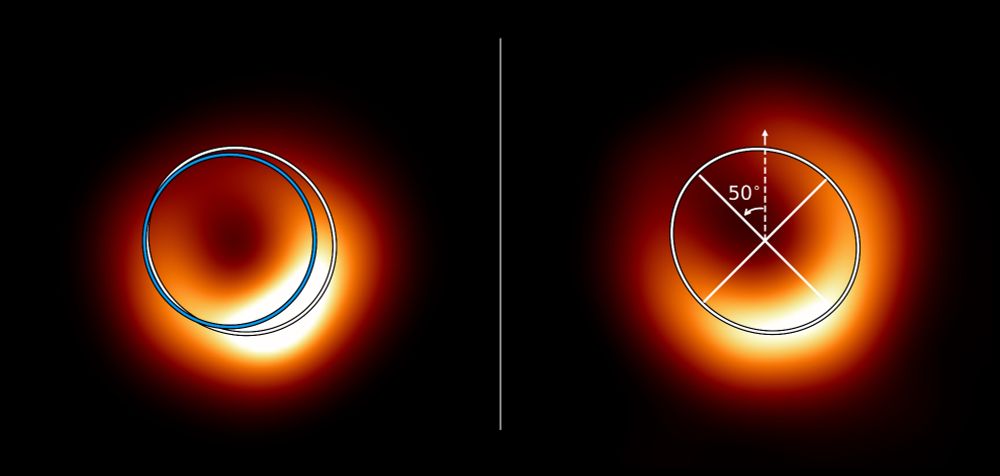
Two glowing yellow and red rings (the black holes) against a black background and separated down the middle by a thin white line. The left black hole has a blue circle and white elliptical shape overlaid. The right black hole has just the elliptical overlaid, with white lines to show how the black hole aligns with the shape.
Imagine a donut...now squash it🍩. That's what the black hole inside M87* looks like!
New EHT research reveals that the squishy distortion is not due to gravity, but the turbulent, swirling plasma around the black hole: www.aanda.org/10.1051/0004... #space #blackhole #astronomy #astrophysics
10.07.2025 13:29 — 👍 156 🔁 19 💬 7 📌 3
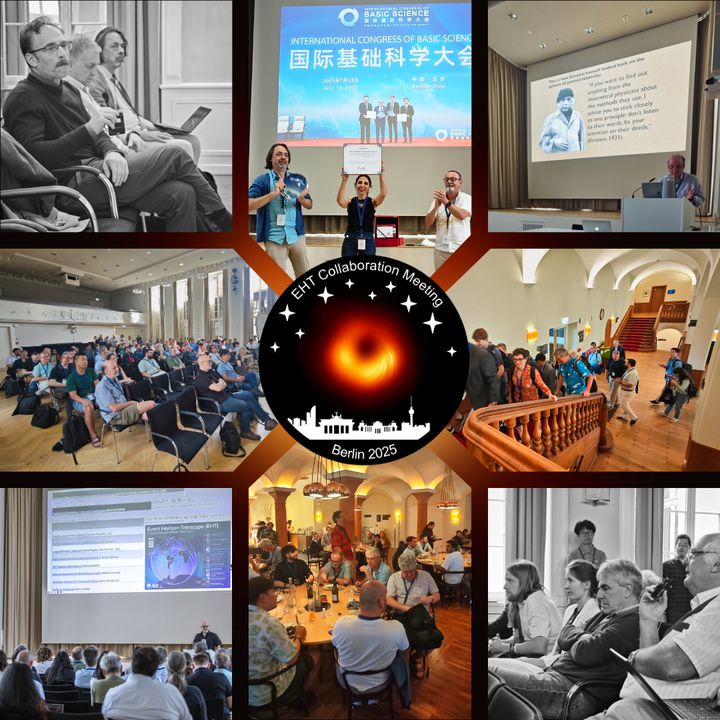
🌍📡 The global Event Horizon Telescope (EHT) team met earlier this month in Berlin for the 2025 Collaboration Meeting!
120+ researchers shared breakthroughs, planned 2026 observations, and discussed turning black hole images into time-lapse “movies.” #astronomy #blackholes #globalscience
01.08.2025 15:27 — 👍 5 🔁 1 💬 0 📌 0
Breaking: NSF is suspending roughly 300 grants with UCLA, following a DOJ finding on Tuesday that the university violated Title VI by "creating a hostile educational environment for Jewish and Israeli students."
31.07.2025 17:53 — 👍 356 🔁 224 💬 22 📌 90

A man sitting in front of a slide for the Distinguished Lecture at CEDAR/GEM 2025
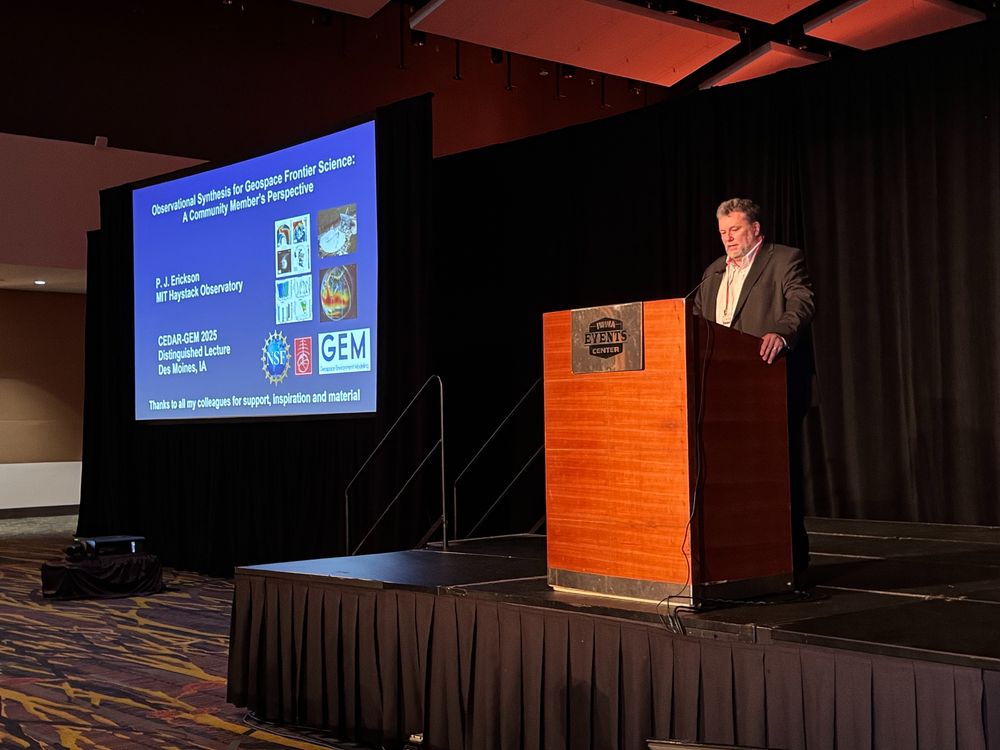
Congratulations to Haystack director Phil Erickson! Phil gave the prestigious CEDAR Distinguished Lecture on June 23 at the recent 2025 NSF joint Coupling, Energetics, and Dynamics of Atmospheric Regions (CEDAR) and Geospace Environment Modeling (GEM) Workshop.
www.haystack.mit.edu/news/erickso...
03.07.2025 19:07 — 👍 3 🔁 1 💬 0 📌 0
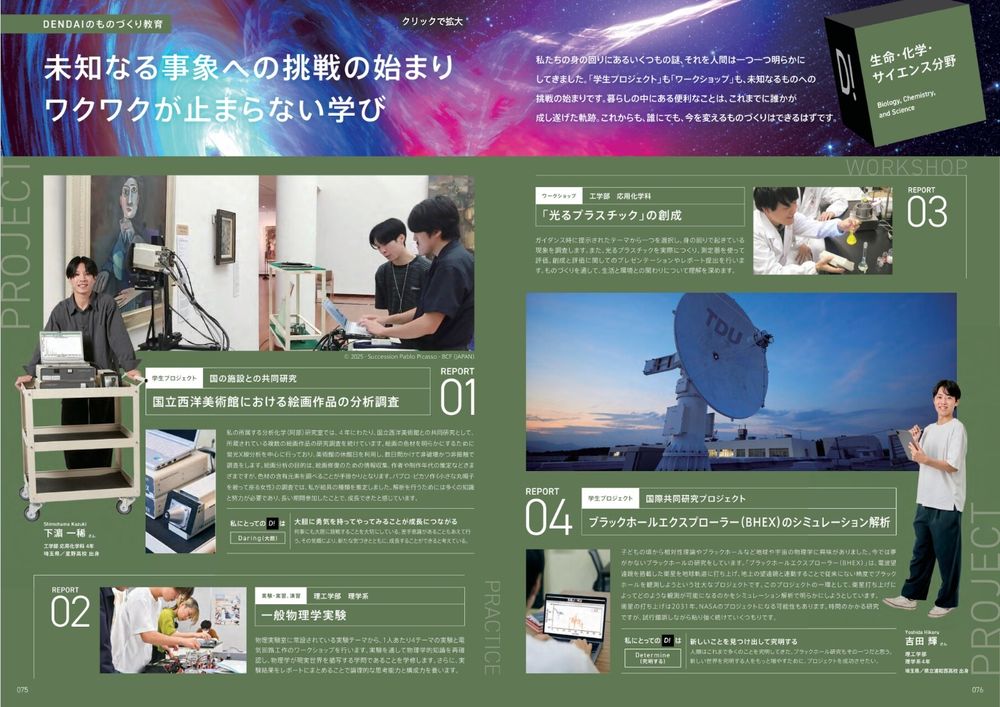
昨年度後半に東京電機大の学部生さんとやった卒論のプロジェクトが、2026年度の入学案内でハイライトされました。日米で検討が進むBlack Hole Explorer Missionの地上観測網に対して膨大な数の観測シミュレーションを行い、その評価をやっていただきました。MITにも来ていただいて、日米の若手研究者の交流の一環ともなりました。
www.d-pam.com/dendai/25143...
24.06.2025 13:12 — 👍 2 🔁 0 💬 0 📌 0
Could you starwatch all night? The IRAM 30-m telescope can!✨🌌 This observing mode is called VLBI, which involves telescopes around the world viewing the same object at the same time, such as a black hole, then combining the data to get super-high-resolution images.
23.05.2025 22:43 — 👍 25 🔁 6 💬 0 📌 2
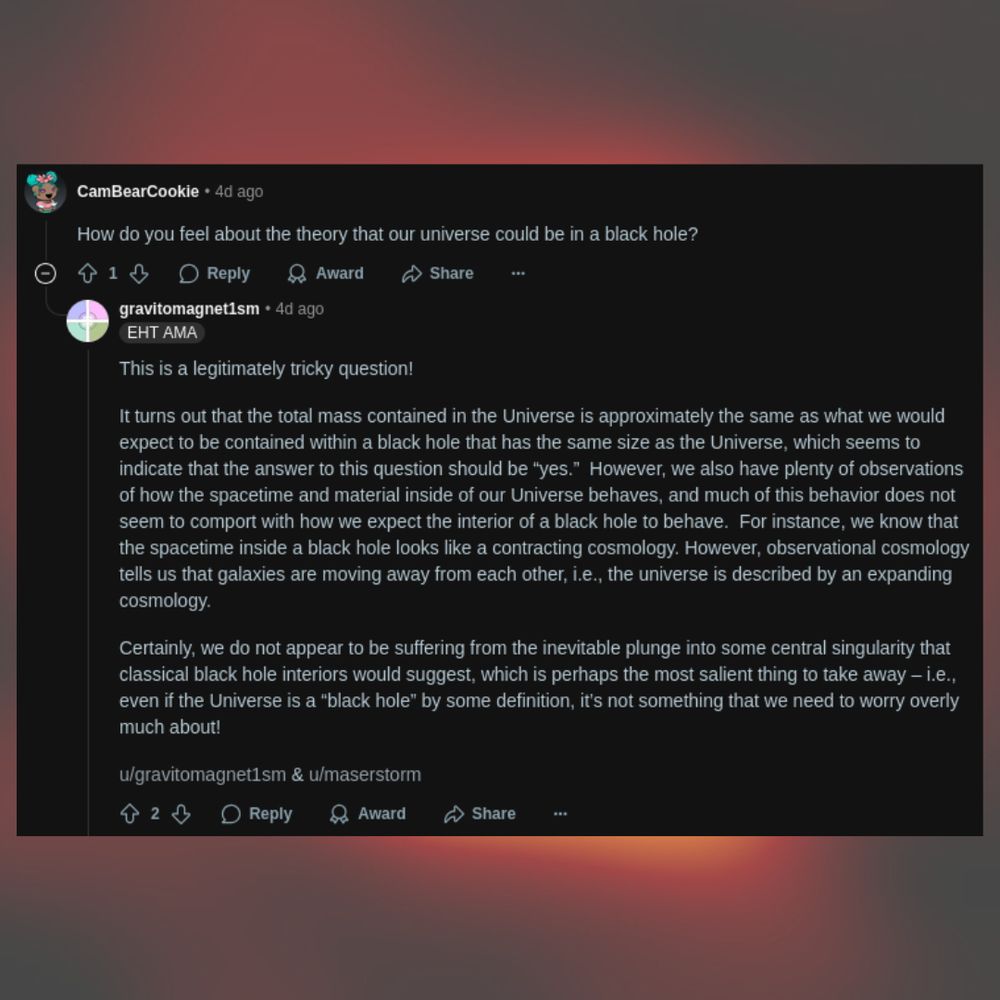
Question: How do you feel about the theory that our universe could be in a black hole?
Answer: This is a legitimately tricky question!
It turns out that the total mass contained in the Universe is approximately the same as what we would expect to be contained within a black hole that has the same size as the Universe, which seems to indicate that the answer to this question should be “yes.” However, we also have plenty of observations of how the spacetime and material inside of our Universe behaves, and much of this behavior does not seem to comport with how we expect the interior of a black hole to behave. For instance, we know that the spacetime inside a black hole looks like a contracting cosmology. However, observational cosmology tells us that galaxies are moving away from each other, i.e., the universe is described by an expanding cosmology.
Certainly, we do not appear to be suffering from the inevitable plunge into some central singularity that classical black hole interiors would suggest, which is perhaps the most salient thing to take away – i.e., even if the Universe is a “black hole” by some definition, it’s not something that we need to worry overly much about!
u/gravitomagnet1sm & u/maserstorm
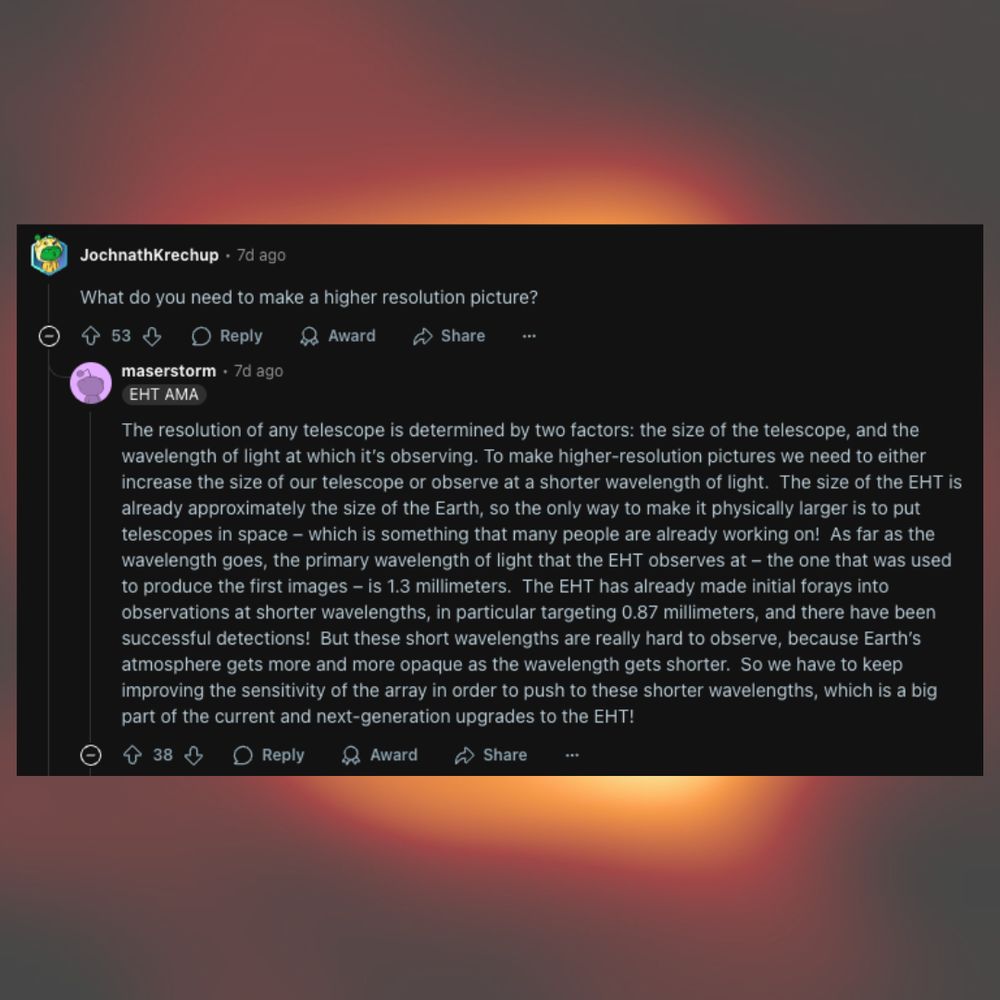
Question:
What do you need to make a higher resolution picture?
Answer: The resolution of any telescope is determined by two factors: the size of the telescope, and the wavelength of light at which it’s observing. To make higher-resolution pictures we need to either increase the size of our telescope or observe at a shorter wavelength of light. The size of the EHT is already approximately the size of the Earth, so the only way to make it physically larger is to put telescopes in space – which is something that many people are already working on! As far as the wavelength goes, the primary wavelength of light that the EHT observes at – the one that was used to produce the first images – is 1.3 millimeters. The EHT has already made initial forays into observations at shorter wavelengths, in particular targeting 0.87 millimeters, and there have been successful detections! But these short wavelengths are really hard to observe, because Earth’s atmosphere gets more and more opaque as the wavelength gets shorter. So we have to keep improving the sensitivity of the array in order to push to these shorter wavelengths, which is a big part of the current and next-generation upgrades to the EHT!
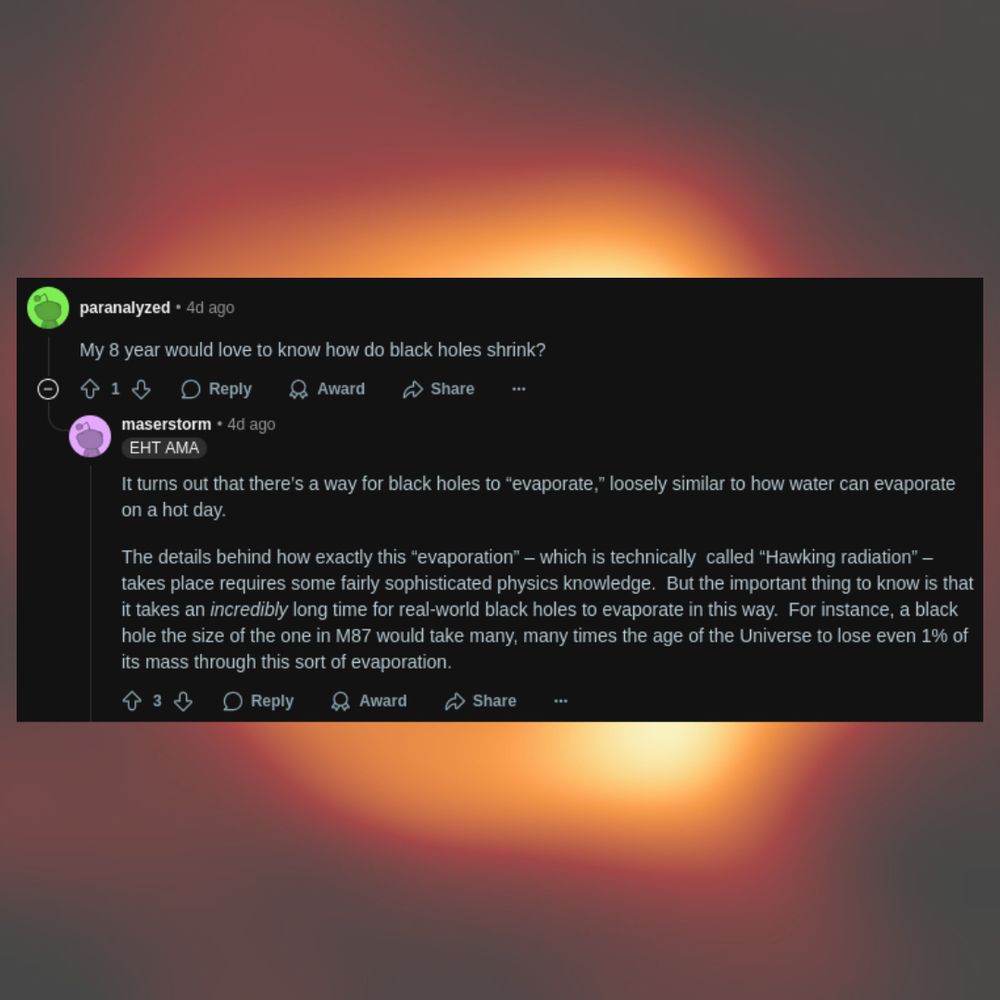
Question: My 8 year would love to know how do black holes shrink?
Answer:
It turns out that there’s a way for black holes to “evaporate,” loosely similar to how water can evaporate on a hot day.
The details behind how exactly this “evaporation” – which is technically called “Hawking radiation” – takes place requires some fairly sophisticated physics knowledge. But the important thing to know is that it takes an incredibly long time for real-world black holes to evaporate in this way. For instance, a black hole the size of the one in M87 would take many, many times the age of the Universe to lose even 1% of its mass through this sort of evaporation.
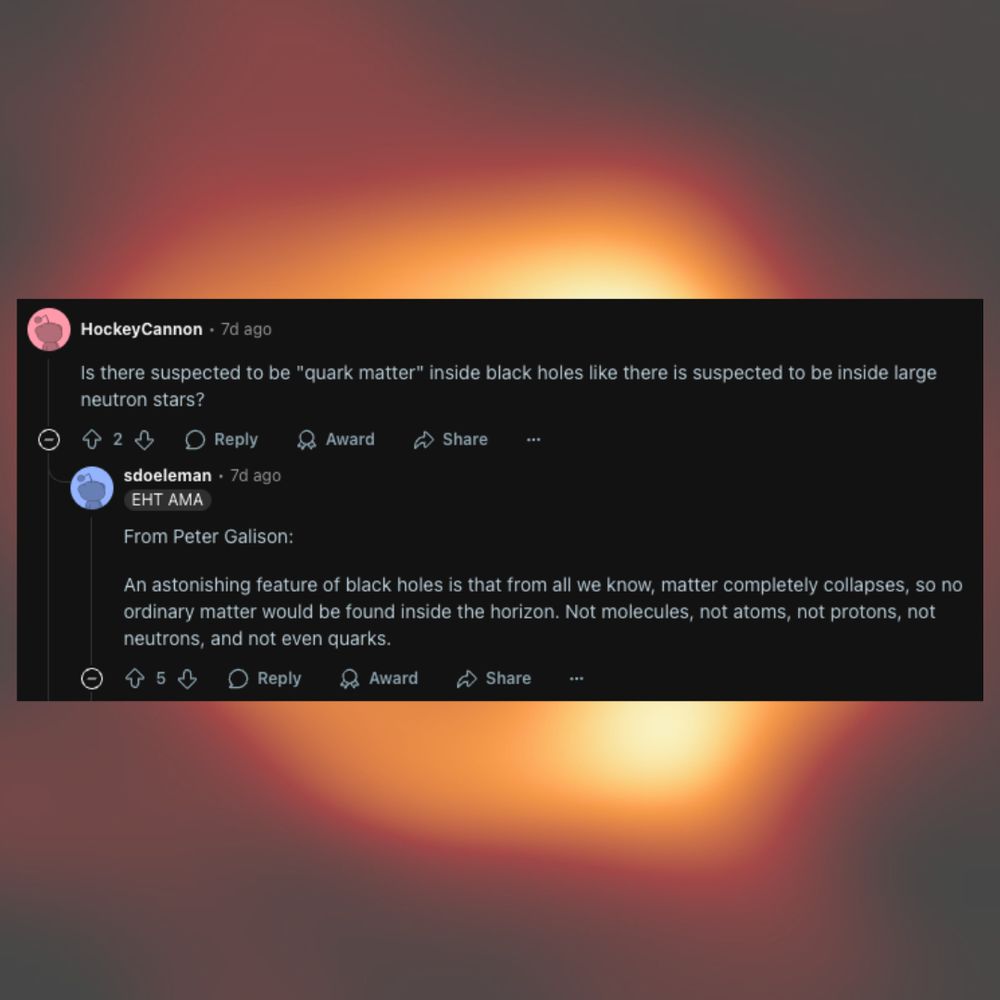
Question: Is there suspected to be "quark matter" inside black holes like there is suspected to be inside large neutron stars?
Answer: From Peter Galison:
An astonishing feature of black holes is that from all we know, matter completely collapses, so no ordinary matter would be found inside the horizon. Not molecules, not atoms, not protons, not neutrons, and not even quarks.
"You asked, we answered!🫡 Here are some of our favorite questions from last Friday's Reddit Ask Me Anything for #BlackHoleWeek2025
Have more questions about the mysteries of black holes❓Read the full thread here: www.reddit.com/r/askscience...
16.05.2025 21:03 — 👍 5 🔁 1 💬 0 📌 0

東北大の田中さん、東京都市大の津村さんにお声がけ頂いていて、天文学の最新成果を解説する本の執筆に参加させていただきました。第一線で活躍している日本を代表する天文学者の皆さんに混ぜていただいて、私は超巨大ブラックホールの章を担当させていただいています。このような著者陣が集まる本は貴重だと思います。来週発売だそうです!ぜひご覧になってください!
www.kawade.co.jp/np/isbn/9784...
21.05.2025 14:25 — 👍 3 🔁 0 💬 0 📌 0
As we've seen this Black Hole Week, black holes have gone from theory to image, from mysteries to measurements. Now, the EHT is entering a new era, where more telescopes around the world — and maybe in space — will capture time-lapse “movies” of black holes. Popcorn, anyone?🎥🍿
12.05.2025 15:16 — 👍 17 🔁 5 💬 1 📌 1
It is starting in 2 hours!
09.05.2025 17:33 — 👍 1 🔁 0 💬 0 📌 0
The AAS is aware of reports of pending restructuring and more grant cancellations at NSF, and is working to learn more and formulate a response. If you have been directly impacted, please share your story (aas.org/form/share-y...) or contact us at public.policy@aas.org.
09.05.2025 15:54 — 👍 13 🔁 8 💬 0 📌 1
AskScience AMA Series: We're Event Horizon Telescope scientists who've taken the world's first black hole photos. Ask Us Anything!
Hey I've been busy grading, but that doesn't mean it's not #BlackHoleWeek! Have burning questions about black holes? Join me and some of my colleagues from @ehtelescope.bsky.social for a Reddit AMA, today from 3-5 PM ET (19-21 UTC)!
09.05.2025 12:08 — 👍 3 🔁 2 💬 0 📌 2
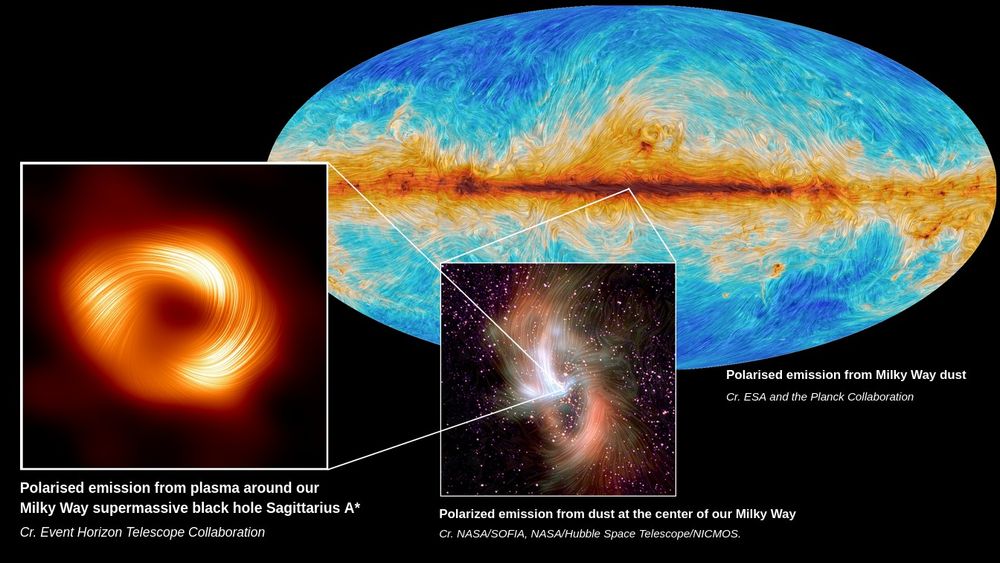
Blue, yellow, and red swirls in an oval shape represent the Milky Way's polarized emission from dust. An inset image in the center of spiraling rust and white shows the polarized dust emission at the center of the Milky Way. An inset image on the left shows streaky spirals of bright yellow and orange around a hazy black center: the Sag A* black hole at the center of the Milky Way.
About 27,000 light years away, with a mass of more than 4 million Suns, lies the Milky Way’s supermassive black hole Sagittarius A*.
If you were to approach it, you’d be deceived by its size - the shadow is roughly twice as big as the black hole’s actual surface!⚫️
08.05.2025 13:57 — 👍 5 🔁 3 💬 0 📌 0
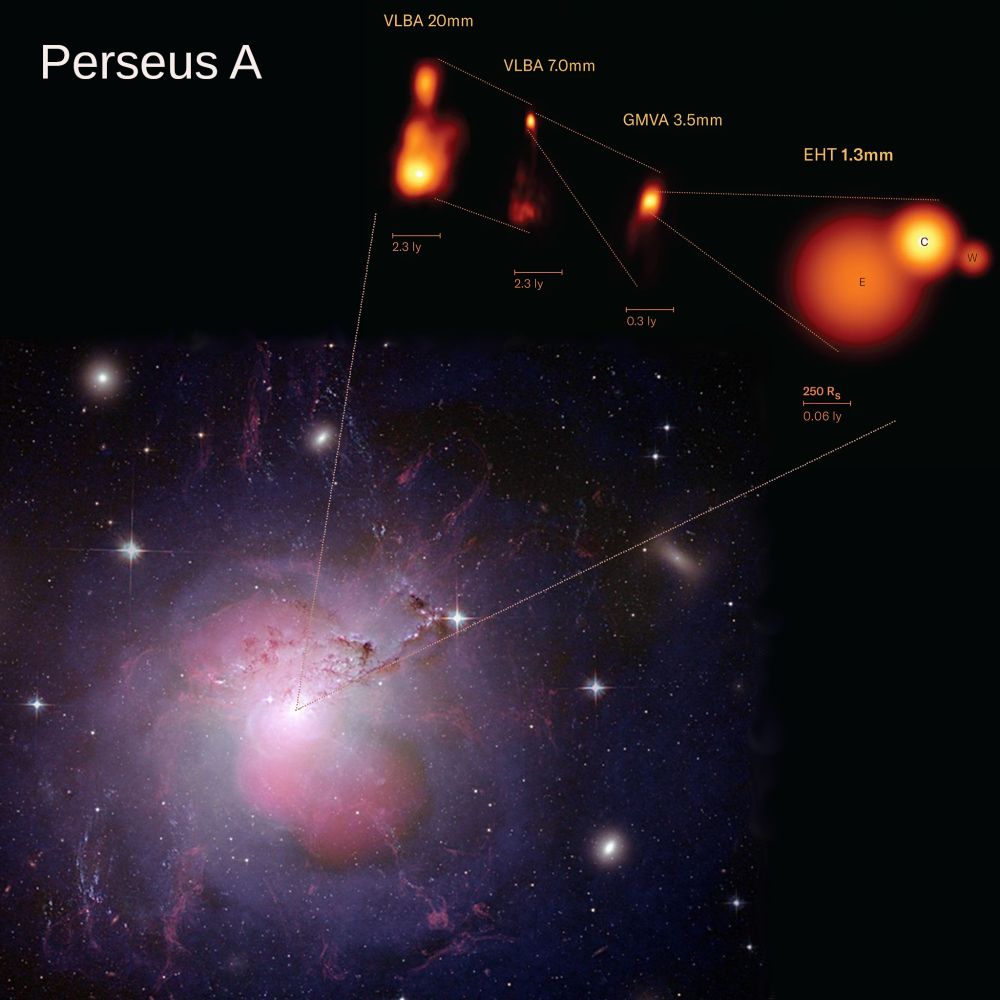
Swirling clumps of purple and pink form a galaxy in the bottom left, set against a dark blue starry sky. To the top right is an inset image of different-sized orange blobs, representing the emission seen by the EHT and other collaborations.
Behold Perseus A, one of the closest active supermassive black holes, at 230 million light years away.
Composite images like this one from the NRAO, Chandra, Hubble, and the EHT can help us study black holes and their environments, which influence each other.🛰️
07.05.2025 13:06 — 👍 10 🔁 3 💬 0 📌 0
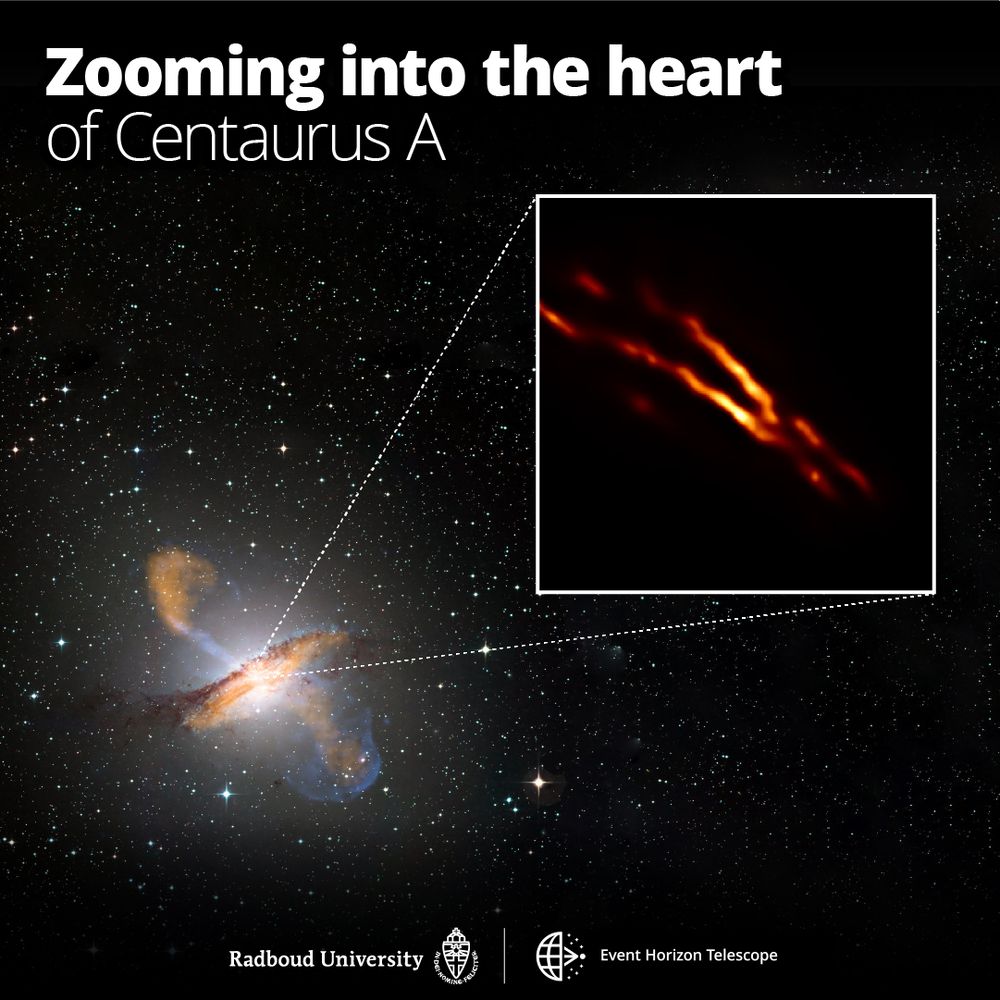
A photo of the galaxy Centaurus A, seen in orange and blue tufts against a black starry sky. There is a inset image to the right that shows two orange lines, which is a zoomed in version of the glowing heart of the galaxy, where the jets reside.
Centaurus A is the closest radio galaxy to Earth. Radio galaxies feature two-sided jets that are ejected from the galaxy’s central black hole and measure up to millions of light years long. These jets are theorized to spread energy and affect the growth of their host galaxies.💫
06.05.2025 13:44 — 👍 41 🔁 8 💬 0 📌 0
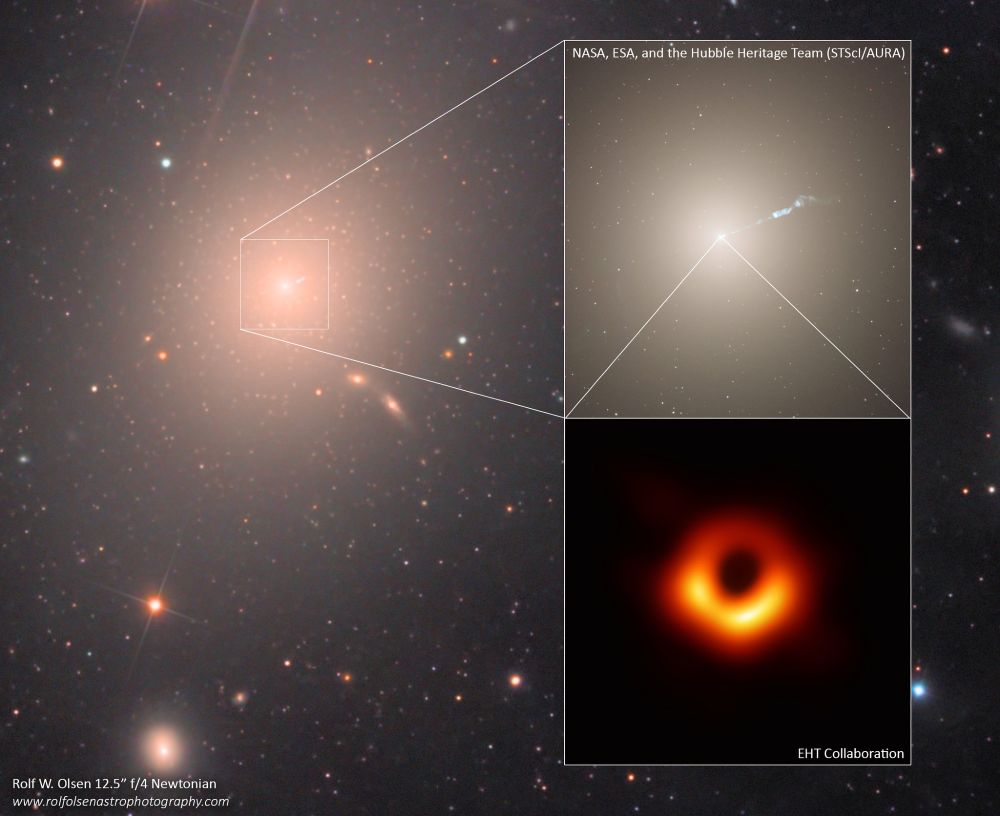
Happy Black Hole Week! This is Messier 87; despite being located about 55 million light years away, the EHT peered at its beating heart in 2017 for its first image.
Did you know that the location of the brightest region around the black hole, and its shadow, can change yearly?🔭 #BlackHoleWeek2025
05.05.2025 13:10 — 👍 31 🔁 7 💬 0 📌 1
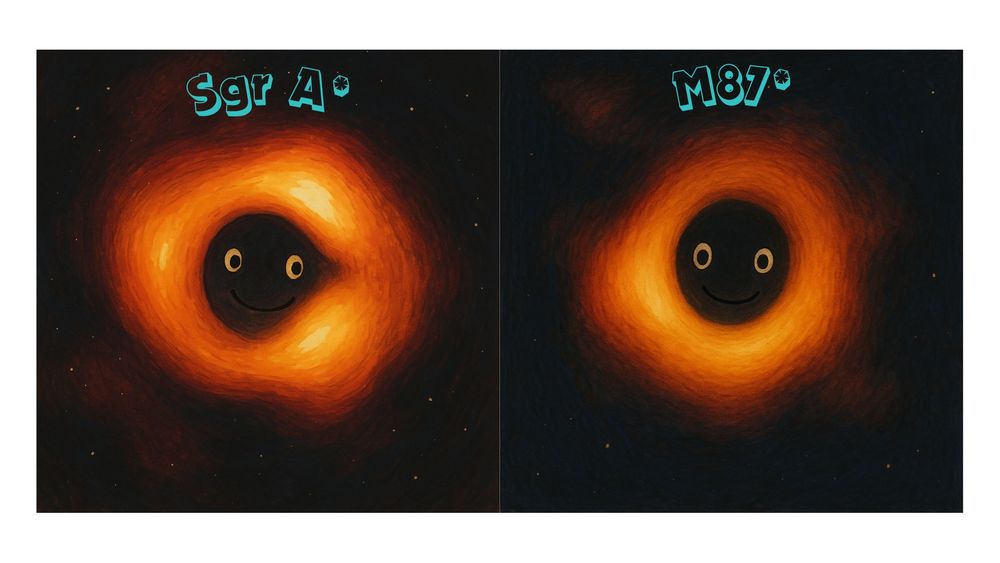
Ever wonder how to study the nature of spacetime and the edges of physics? These mischievous black holes have a clue!
Join the Event Horizon Telescope for #BlackHoleWeek2025, May 5th-9th, as we highlight pieces of the black hole science jigsaw puzzle.🌟 #astronomy #astrophysics #blackholes
02.05.2025 23:15 — 👍 9 🔁 1 💬 0 📌 0
AAS Week of Action 2025 | American Astronomical Society
Federal funding for science is currently under grave threat. We need you to take action this week, and thereafter, to remind Congress of the importance of federal funding for the sciences.
If you are US residents or citizens and support science, please join us the “Week of Action 2025” organized by the American Astronomical Society (@aas.org) next week. Call your representatives and let’s remind Congress why federal funding for science matters.
aas.org/posts/news/2...
03.05.2025 02:20 — 👍 4 🔁 3 💬 1 📌 0
We can't sustain the innovation, education, and discovery under the weight of such devastating cuts to science funding. These measures will only benefit our global competitors, erode the nation's international reputation, and undermine the most efficient engine that has been powering the US.
03.05.2025 02:20 — 👍 2 🔁 1 💬 0 📌 0
Action Alert 2025 | American Astronomical Society
Please join us NOW to urge support for astronomical science programs in the US to your senators and representatives in Congress. AAS provides a tool to make it easier.
aas.org/advocacy/get...
03.05.2025 02:20 — 👍 1 🔁 0 💬 1 📌 0
AAS Week of Action 2025 | American Astronomical Society
Federal funding for science is currently under grave threat. We need you to take action this week, and thereafter, to remind Congress of the importance of federal funding for the sciences.
If you are US residents or citizens and support science, please join us the “Week of Action 2025” organized by the American Astronomical Society (@aas.org) next week. Call your representatives and let’s remind Congress why federal funding for science matters.
aas.org/posts/news/2...
03.05.2025 02:20 — 👍 4 🔁 3 💬 1 📌 0

Trump’s proposed budget would mean ‘disastrous’ cuts to science
Key research budgets would shrink by one-third to one-half in 2026 spending plan
President Donald Trump today asked Congress to make massive and unprecedented cuts to the 2026 budgets of major federal science agencies. scim.ag/3Yszqnm
02.05.2025 22:06 — 👍 97 🔁 58 💬 10 📌 7

Trump proposes unprecedented budget cuts to US science
Huge reductions, if enacted, could have ‘catastrophic’ effects on US competitiveness and the scientific pipeline, critics say.
US President Donald Trump’s proposed budget for fiscal year 2026 calls for unprecedented cuts to scientific agencies that, if enacted, would deal a devastating blow to US science, policy specialists say.
https://go.nature.com/4jYv3IP
02.05.2025 22:25 — 👍 125 🔁 70 💬 8 📌 10
The official account for Jimmy Kimmel Live with Jimmy Kimmel on ABC! We have fun. #Kimmel youtube.com/@JimmyKimmelLive
Just a tired black cat. Occasionally making progress on astronomy. PhD candidate, musician, photographer. github.com/SterlingYM
Mathematician at UCLA. My primary social media account is https://mathstodon.xyz/@tao . I also have a blog at https://terrytao.wordpress.com/ and a home page at https://www.math.ucla.edu/~tao/
Pediatric hem/onc --> Biomedical research --> Organ/harpsichord/church music
"You cannot escape the responsibility of tomorrow by evading it today.” – Abraham Lincoln 🏴☠️ | Home of #TheBreakdown and LP Podcast
Committed to the daily re-imagining of what a university press can be since 1962.
Website: https://mitpress.mit.edu // The Reader (our home for excerpts, essays, & interviews): https://thereader.mitpress.mit.edu
Historian of Science, Kyoto University. Posts mostly in Japanese. 科学史家 『励起:仁科芳雄と日本の現代物理学』の著者.重要なことは印刷物に書くので,ここには書きません.
I’ve boldly gone into the clear blue yonder. Follow for more recipes and tips.
📷”The Aurora Guy”
🌌Space Physics Ph.D. student
📍North Pole, Alaska
🫂Participatory science, science comm.
🌀 Professional aurora chaser
👨💻Views my own
science journalist | good physics, bad physics, and sometimes ugly physics
Signal: dgaristo.72
Email: digaristo@gmail.com
Data scientist specializing in radar. Maintainer of radioconda (https://github.com/ryanvolz/radioconda).
Astrophysicist: multi-messenger observations at high-energies, H.E.S.S./CTA; SVOM, ANTARES, etc.
PI of Astro-COLIBRI (https://www.astro-colibri.science)
Welcome to the official account of SPIE, the international society for optics and #photonics. Over the past five years, we have invested over $25M in the international optics community! 💡
Astronomer, software engineer. Supporting space telescopes, open science, and accessibility in astrophysics.
Thrilled and haunted by dots on stars.
http://brettmorr.is/
Posts my own, not my employer's.
Science News from Academic Journals etc.
Research, news, and commentary from Nature, the international science journal. For daily science news, get Nature Briefing: https://go.nature.com/get-Nature-Briefing
Cutting-edge research, news, commentary, and visuals from the Science family of journals. https://www.science.org
Advancing science, serving society.
One of the world’s largest general scientific societies and publisher of @science.org






















